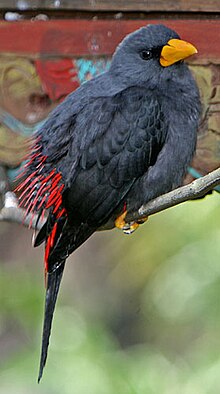Grosbeak starling
| Grosbeak starling | |
|---|---|

| |
| Scientific classification | |
| Kingdom: | |
| Phylum: | |
| Class: | |
| Order: | |
| Family: | |
| Genus: | Scissirostrum Lafresnaye, 1845
|
| Species: | S. dubium
|
| Binomial name | |
| Scissirostrum dubium (Latham, 1801)
| |
| Synonyms | |
|
Lanius dubium Latham, 1801 | |
The grosbeak starling (Scissirostrum dubium), also known as the grosbeak myna, finch-billed myna, or scissor-billed starling, is a species of starling in the family Sturnidae. It is monotypic in the genus Scissirostrum.[2] It is endemic to Sulawesi, Indonesia.[1]
Its natural habitat is tropical lowland, and sometimes subtropical montane, lightly wooded forest areas and wetlands.[1]
This species nests in colonies, which frequently contain hundreds of pairs. Its nests are bored in rotting or dying tree trunks in woodpecker style. It eats fruit, insects, and grain.[2]
Grosbeak starlings are highly vocal, at their colonies and in feeding flocks.[2]
The grosbeak starling was first described by the English ornithologist John Latham in 1801 under the binomial name Lanius dubium.[3]
References
- ^ a b c Template:IUCN
- ^ a b c Feare, C., Craig, A., Croucher, B., Shields, C., & Komolphalin, K. 1998. Starlings and Mynas. Christopher Helm. ISBN 0-7136-3961-X
- ^ Latham, John (1801). Supplementum indicis ornithologici sive systematis ornithologiae (in Latin). London: Leigh & Sotheby. p. xviii.

